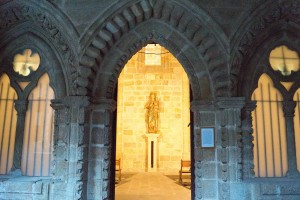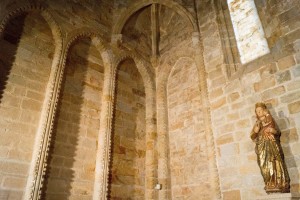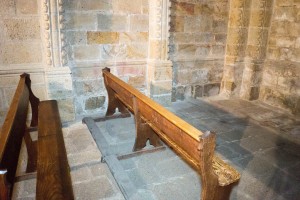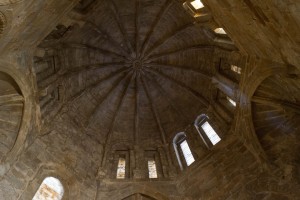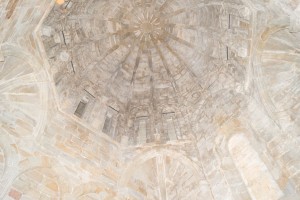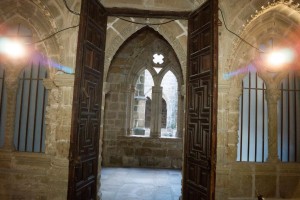Managing Church Affairs
[/lab_heading]
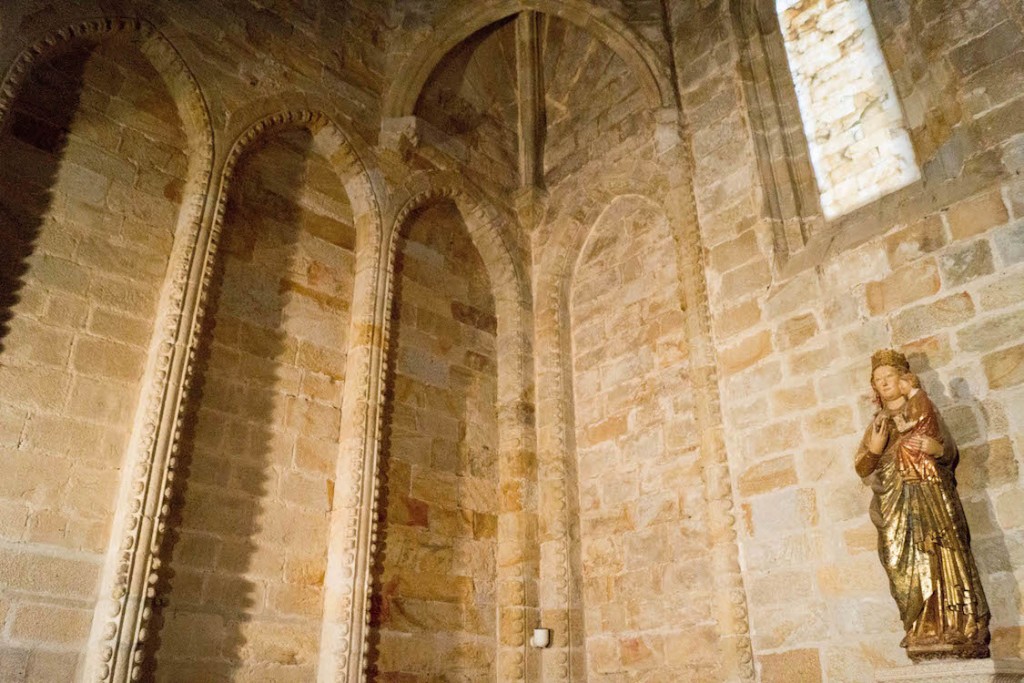
View inside the Chapel of St. Paul.
The Cathedral Chapter (Cabildo de la Catedral)
This selection from: Martinez, Roger Louis (2008). From Sword to Seal: The Ascent of the Carvajal Family in Spain (1391-1516). Doctoral dissertation. UMI Number: 3324682.
Fundamental to the ecclesiastical strength and autonomy of Catholic dioceses in the Kingdom of Castile during the late 14th and early 15th centuries were the significant local powers the Catholic Church bestowed upon them. In each of Spain’s regional ecclesiastical benefices, including the Diocesis of Plasencia, a bishop (obispo) and cathedral chapter (cabildo de la catedral) governed the jurisdiction. Although, both the bishop and the cathedral chapter were involved in the leadership of the local cathedral, the chapter dominated local affairs and decisions. From 1375 to 1422, there was considerable tension and turbulence within the administration of the diocese. In at least three cases, Plasencia’s bishops found themselves in conflict with the cathedral chapter and the local community. Critical to creating the conditions necessary for a smoothly operating cathedral was the bishop’s tacit acceptance of the chapter’s authority over the diocese.
Local cathedral chapters and bishops derived their specific authority to govern their dioceses by virtue of papal authority. Cathedral administrative chapters began to appear in Castilian churches during the 12th century. At that time, the pope granted to the chapters all his rights and privileges provided they were “used for the local common good of the diocese.” Bishops similarly derived their authority from Catholic canon law, which specified, “bishops as the successors of the Apostles, and by divine order…they are placed [them] to lead and govern the church in all matters under the authority of the Roman Pontificate.” Empowered as such, in theory, a bishop administered absolute ecclesiastical and sacramental authority within their respective geographic jurisdictions and only the pope could remove them from office. However, by the 12th century, cathedral chapters retained their own competing authority over the diocese.
Castilian kings found themselves equally constrained by the local authority of churchmen. Since King Alfonso X’s creation of Las Siete Partidas in the 12th century, monarchs obligated themselves not only to protect and guard, and but also not to interfere with church property and goods. Thus, an intricate web of relationships bound the king, pope, bishop, and cathedral chapter. While royal and papal authority were supreme in their own rights, with each step away from the royal and church centers in the cities of Burgos and Rome, those powers weakened and local power grew. In this manner, the Cathedral of Plasencia shared much in common with other late medieval Castilian “frontier” ecclesiastical centers, like the Cathedral of Segovia, where, “ecclesiastics [were] liberated by distance and environment and from the constraints authority,” as well as similar institutions in Italy, France, and England.
[/lab_scroll_box]

B2568. Las Siete Partidas. Hispanic Society of America (New York, NY)
King Alfonso X “El Sabio”‘s Las Siete Partidas
The cathedral chapter governed every aspect of the Diocese of Plasencia’s ecclesiastical and secular activities. These not only included the saying of regular masses, but also payment of church officers, the management of church properties, and collection of church rents and taxes. While the bishop was the local “lord” of the church, the chapter had significant control over the administration of the diocese. Often Placentino bishops hailed from other cities in Spain and were physically absent from Plasencia while attending to affairs in the king’s Royal Court (Real Audiencia). In fact, for over thirty years (from the 1390s to 1423) not a single sitting bishop of Plasencia appeared to be present physically at any of the recorded meetings of the cathedral board. This routine absence of bishops from the Diocese of Plasencia generally promoted a strong self-identification and reliance on self-governance by the cathedral chapter.
In the Castilian western frontier of the Extremadura, far from Burgos and Rome, the Diocese of Plasencia perceived itself as a self-administering local institution. When the Dean and church officers met to discuss administrative matters, in most cases in the Chapel of Saint Paul (Capilla de San Pablo), they did so by invoking their own, not the bishop’s, authority. They communicated their authority not in the name of the king, the pope, or even the bishop, but in the name of “the Dean and the Cathedral Chapter.” Additionally, from the diocese’s perspective, the bishopric belonged to the governing chapter and not to the bishop. The invocation of the cathedral’s Actas Capitulares, the local church’s official record of its business affairs, states: “In the name of God who made all things: This is the Book in which are written and described the possessions of the Dean and the Chapter of the Church of Plasencia and all of its Bishopric.”[/lab_scroll_box]
Chapel of St. Paul (Capilla de San Pablo)
[/lab_scroll_box]
Typically, in the Kingdom of Castile and Leon, a cathedral chapter’s membership included its dean, who served as its presiding officer; archpriests (archiprestes) who oversaw the clergy and religious services; archdeacons (arcedianos) who administered all church business affairs and participated in religious services; the cantor (chantre) whose role included overseeing and leading the choir, but also other unspecified duties; a church treasurer (tesorero); and a headmaster of the church school (maestrescuela). Often, cathedral records refer to this group as the diocese’s ecclesiastical dignitaries (dignidades eclesiasticas.) Bishops depended highly on the chapter, primarily composed of prominent families from the local community, for advice on the peculiarities of governing their territories.[/lab_scroll_box]
A Historical Snapshot of Church Leaders in Plasencia (from the Actas)
[/lab_scroll_box]
| Members |
|---|
| Gonzalo García de Carvajal, Archdeacon of Plasencia and Béjar (Dean for part of 1424) |
| Gil Martínez de Soria, Archdeacon of Trujillo and Medellín and Vicar General |
| Alfonso Rodríguez de Maluenda, Archdeacon of Coria. |
| Gonzalo Gutiérrez de la Calleja, Tresurer |
| Sancho Ortiz de Estuñiga, Canon (Dean for part of 1424) |
| Diego Blasquez, Canon (Dean for part of 1425) |
| Andrés Pérez, Canon (Dean for part of 1425) |
| Gil Gutierrez de la Calleja, Prebendary |
| Alfonso Gutierrez de la Calleja, Prebendary |
| Diego Martinez de Soria, Prebendary |
| Blasco Gómez de Almaraz, Prebendary |
| Pedro González, Prebendary and Notary |
| Juan Sánchez, Sacristan |
| Gómez Fernández, Canon |
The Actas Capitulares indicate the church’s canons and prebendaries managed most of the routine administrative affairs relating to church property, taxes, and salaries. From its cadre of canons, the chapter selected its archdeacons. These Archdeacons had the authority to hire their own prebendaries, which often were family members or close associates. In all business transactions, one of several church notaries recorded the critical elements and terms of transactions, as well as documented church officials presiding over these events, and other attending other parties and witnesses.[/lab_scroll_box]
